How Do You Read A CHIRP Fish Finder?
UPDATED 17 MAY 2023
by Robert Ceran
Fish finders help anglers catch more fish. However, they come in a bewildering variety of models, each with different specifications, and with different combinations of sonar technologies.
If you want to take advantage of the full potential of fish finders to help you catch more fish, you need to understand the basics of sonar signaling, and how you can use different types of sonar for your specific needs.
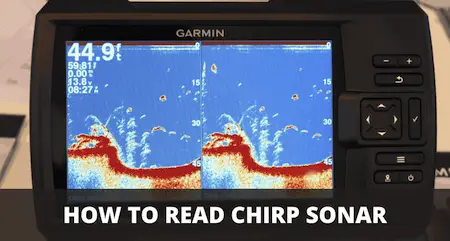
In this article we’ll show you how to read CHIRP sonar, which is one of the most powerful sonar technologies available for fish finders.
What is CHIRP sonar?
CHIRP stands for Compressed High Intensity Radar Pulse, and is not actually a separate sonar technology, but rather an improved version of traditional 2D sonar.
So, if you’re wondering, what is the difference between CHIRP and traditional sonar, it’s this: while traditional 2D sonar relies on a single frequency to gather sonar information, CHIRP sonar uses a combination of different frequencies to gather more complete and more detailed information.
The exact wavelength used by traditional 2D sonar depends on the depth of water in which you want to use it.
For example, in water less than 200 ft. deep, the frequency is usually 200 kHz (see table 1 below), which covers most freshwater and inshore applications.
| Low frequency 2D sonar | Medium frequency 2D sonar | High frequency 2D sonar |
|
|---|---|---|---|
| Frequency | 50 kHz | 83 kHz | 200 kHz |
| Cone size | Wide cone, 27 degrees | Medium cone, 20 degrees | Narrow cone, 13 degrees |
| Water depth | > 300 ft. | 200-300 ft. | < 200 ft. |
Table 1: Traditional 2D sonar relies on a single frequency, which can range from 50 to 200 kHz, depending on the water depth.
In contrast, CHIRP relies on sending out more numerous sonar pulses that cover a combination of many frequencies, sending out as many as 100 different frequencies. For water that’s less than 200 ft. deep, high frequency CHIRP is used, which covers 150 to 250 kHz (see table 2 below).
| Low frequency CHIRP | Medium frequency CHIRP | High frequency CHIRP |
|
|---|---|---|---|
| Frequency | 42-65 kHz | 95-155 kHz | 150-250 kHz |
| Cone size | Multiple sizes, ranging from 21 to 32 degrees | Multiple sizes, ranging from 16 to 24 degrees | Multiple sizes, ranging from 11 to 16 degrees |
| Water depth | > 300 ft. | 200-300 ft. | < 200 ft. |
Table 2: CHIRP sonar relies on a combination of frequencies, which can range from 42 to 250 kHz, depending on the water depth.
Since every object underwater has a slightly different consistency, it responds differently to a single frequency of sonar. However, by using several different frequencies at the same time, it’s possible to compensate for these differences, which results in a more complete picture, plus better object separation.
How to read CHIRP sonar
While reading CHIRP sonar is similar to reading regular 2D sonar, it also has clear differences (for more details on this, check out our article on how to read a fish finder).
The most important aspect of using a CHIRP fish finder is the ability to use it to reliably identify fish close to your boat. There are two basic ways to do this:
- Fish arches
- Fish icons
Fish arches
Fish show up as arches on a CHIRP display due to the fact that they tend to move through the sonar cone, and therefore cast back a slightly different signal depending on where on the cone the sonar signal encounters them, which results in an arched line on your display. For more information on the sonar cone read our article on how fish finders work.
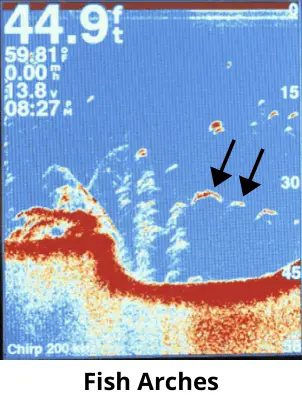
Fish arches can be very diverse in size, length and shape. Sometimes they look more like half arches, or more like short lines. This happens if the fish aren’t moving through the cone. So you have to get some practice identifying all of these different types of arches as fish.
Fish icons
Most fish finders nowadays have what’s called “Fish ID” technology. Basically, if you enable this function, the fish finder will automatically interpret the arches and label them as fish for you, so you don’t need to worry about getting it right. This feature is ideal if you’re a beginner, and not sure how to tell which signals correspond to fish.
If you have a CHIRP fish finder, and aren’t getting clear signals like this, your transducer may not be working properly. In that case, there are several things you can do to check if your transducer is working or not.
How to judge fish size with CHIRP
Many anglers mistakenly believe that a longer arch signifies a bigger fish, but this is incorrect. Arch length doesn’t correlate with fish size, it simply indicates that a particular fish spent a long time swimming through your sonar cone. Instead, you should use arch thickness to judge fish size. A larger fish casts back a stronger sonar signal than a small one, which shows up as a thicker arch on your screen.
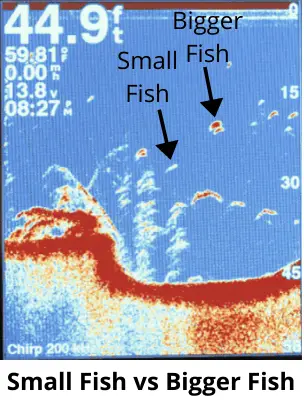
Many fish finders use a color code on their display, with stronger signals returning a different color than weaker ones, which helps a lot to distinguish large fish from small ones.
How to identify bait fish with CHIRP
Since you can use arch thickness to judge fish size, you’ll be able to identify individual small fish as narrow arches, dashes or lines on your screen. However, as you know, bait fish often like to swim in a tight group formation, also known as “bait balls.” Bait balls look like a fuzzy cloud on your display, since it’s hard to distinguish individual fish within a bait ball.
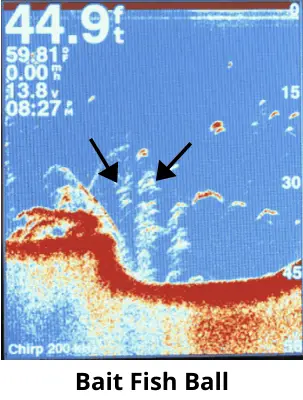
It’s important to learn how to tell the difference between a bait ball and underwater vegetation. Bait balls are usually suspended and moving in the water, while vegetation is attached to the bottom. Also, many fish finders label them in different colors.
In case you want to use a regular CHIRP fish finder for ice fishing, that’s absolutely possible. You can even use it to shoot sonar directly through the ice to identify fish without drilling a hole (for more on this, check out our article on can a fish finder work through ice?).
If you have a CHIRP transducer, make sure you don’t run it out of water, since it tends to overheat very quickly, which will damage its function. For more details on this, take a look at our article can you run a fish finder out of water?
How to identify bottom topography with CHIRP
Fish finders are also great for scanning underwater landscape and topography, which you can use to find promising fishing spots.
The most important way to do this is by looking for prominent structures underwater, such as large boulders or sunken trees, which often attract fish.
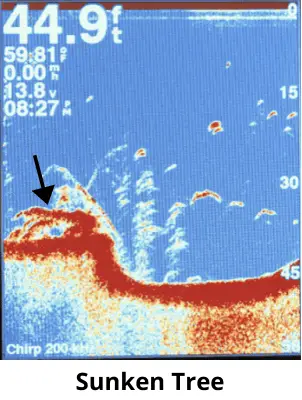
In addition, you should also look for transition areas. An example of this would be a sudden drop off from shallow to deeper water, or areas where the sediment consistency changes (which can usually be detected as changes in color, or changes in signal intensity on your screen).
Transition areas like this often attract a lot of fish. If your fish finder has GPS functionality, you can place markers on these structures, which makes it easy to find them again.
Want to take a look at a high end fish finder that use CHIRP sonar? Take a look at our Garmin Striker a review.
Is CHIRP sonar worth it?
Here’s a question I often hear: “is CHIRP better than sonar?” Well, first of all, it’s not a separate technology, but rather an improved version of traditional sonar.
And yes, CHIRP is absolutely worth the additional cost, since it gives much more detailed information about what’s below your boat, with excellent separation of objects that are close together.
One of the weaknesses of traditional 2D sonar has always been relatively poor object separation, and CHIRP significantly improves on this performance. It can detect down to 1.5 inches of object separation, which is often good enough to identify individual bait fish in a school, and in some cases it can even detect a single fish resting on the bottom, which 2D sonar can’t do.
In addition, it also gives a better temporal (time based) resolution, which means you’ll be able to follow movements of fish in real time, as well as your fishing lure moving in the water.
If you’re thinking about buying a new fish finder with CHIRP, take a look at our review of the best fish finder under 300 dollars.
And if you’re interested in using CHIRP for ice fishing, check out our review on the top ice fishing flashers and fish finders.
